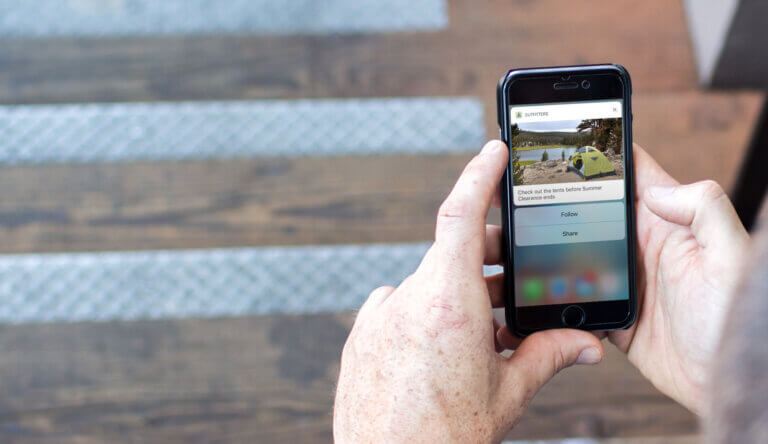
Push Notification Strategies Top Social Media Brands are Using: What Digital Marketers Can Learn
“2 new interactions!” “Moderate traffic in your area.” “Boston’s Kelly DL’d with hamstring strain.” “Cody Smith likes Tanya Cole’s photo.”
Most of us are on the receiving end of a steady trickle of push notifications just like these throughout each day. Some are relevant or even important, and others are just plain annoying.
Yet, despite the annoyance factor, the biggest social media apps send us notifications all the time — because it works. The simple truth is that push notifications keep us engaged. They remind us that the app is there, enticing us to return and engage more, and creating even more fodder for future notifications throughout our social graphs. And social media apps are continually experimenting to get better at engaging us.
Striking the Right Balance
But even some of the most prolific notification senders question the benefits of push as a blunt growth hack.
Evan Spiegel, CEO of Snap Inc., indicated some distaste for the overuse of push notifications to spur user engagement growth when the company announced its first public quarterly earnings in May and its performance failed to meet expectations.
Regarding the relatively slow user growth of Snapchat versus its competitors, he said, “I think one of the reasons why it’s such a popular question is because there’s a lot of this thing in our industry called growth hacking, where you send a lot of push notifications to users or you try to get them to do things that might be unnatural, or something like that.”
App providers must strike a balance between providing value and getting value from push notifications. The best push notifications are a win/win for brands and their app users.
The most prominent social platforms have been perfecting their approach to push notifications for years, one experiment at a time. Here’s how Twitter, Snapchat and Instagram have done it:
Twitter’s Recommendation Tweaks
Twitter continually tweaks its push notifications, striving to deliver the most value and relevance while reducing the annoyance of too many unwelcome messages on users’ home screens.
Twitter was one of the first to adopt rich push notifications that include thumbnails and expandable images, which data findings show improves direct open rates by more than 50 percent on average.
Like the other big social platforms, Twitter developed algorithms to tease out suggestions for users, prompting notifications that recommended that people follow accounts that are also followed or retweeted by multiple people in their networks.
But a good push to one user can be a bad push to another. As often happens when new forms of notifications emerge, people balked. So Twitter adjusted the service to clearly emphasize how people could turn it off. Now, people who want to uncover new accounts appreciated by peers in their networks can maintain the default setting, and others can disable the recommendation notifications.
Snapchat Pushes User Anticipation
And then there was Snap, whose CEO reportedly favors creative product innovations as the keys to driving user engagement growth, as opposed to slamming users with push notifications, which can backfire. But that doesn’t mean Snapchat hasn’t been a “needy” app or innovative, depending on how you view it.
Snap builds user anticipation with lock-screen alerts notifying users that a friend “is typing.” Whether or not people like those notifications, they are clever because they elicit a very natural human response, says sports app expert Matt Restivo, general manager at BAMTech.
“It keeps you on that screen waiting for a response, which is how humans naturally converse,” he argued in a Quora post, adding, “Snapchat is indeed trying to make this feel like a real conversation, and on their end, increase engagement.”
Scarcity Sparks Interest for Instagram
Just like some product releases generate demand through limited supply, some social apps attempt to spark increased interest through scarcity.
Reportedly, Instagram and other apps have tested pooling likes or other interactions that normally would have prompted individual notifications into larger bulk pushes. The idea is to gauge whether some users respond with higher engagement levels when notifications come in lower volume but pack a bigger punch. Instagram also maintains extremely fine-tuned preferences in its push notification settings.
Arguably, social networks’ business models live or die by their growth in monthly active users, and research has found that greater notification frequency leads to greater mobile app retention rates among new users.
This doesn’t mean that some people won’t be upset or see too many notifications as intrusive or annoying, but it’s a far cry from days of yore “Tell your friends what’s on your mind. Post an update,” or reminders that it’s your or your ex’s birthday tomorrow, which were once commonplace.
Giving your customers control over what they get or don’t get as notifications, and truly listening to their signals through automation and machine learning, can help you avoid bad push notifications that risk deletion by those who are very likely your best customers.
Tips for Good Push Notifications
Customize notifications: User data showing preferences, behavior, location and preferred usage times is a treasure trove for fine-tuning notification content, targeting and automation. You can also ask them what they want to receive and provide fine-grained controls.
Consider in app marketing messages: Not every push deserves a shove. Some items don’t warrant a home screen notification that could annoy, and are better served by delivering an in app message.
Make it worth their while: Users expect instant gratification when they click on a notification. Ensure that the messages linked to notifications provide real value and relevance. Strive to deliver value through the message itself versus always teasing users for app opens.
Adopt rich, interactive formats: From new notification priorities in Android O to including media and buttons within messages themselves, app marketing teams have more tools at their disposal to spark user intrigue and gain a better understanding of what users care about directly from the message itself.
For insight on which tools marketers are using or piloting to drive better engagement from their users, see highlights from Forrester Research’s April report, “The State of Mobile Marketer Tactics.”
Subscribe for updates
If the form doesn't render correctly, kindly disable the ad blocker on your browser and refresh the page.
Related Posts


Get Smart About Your Mobile Notifications Strategy to Avoid “Tune Out”
